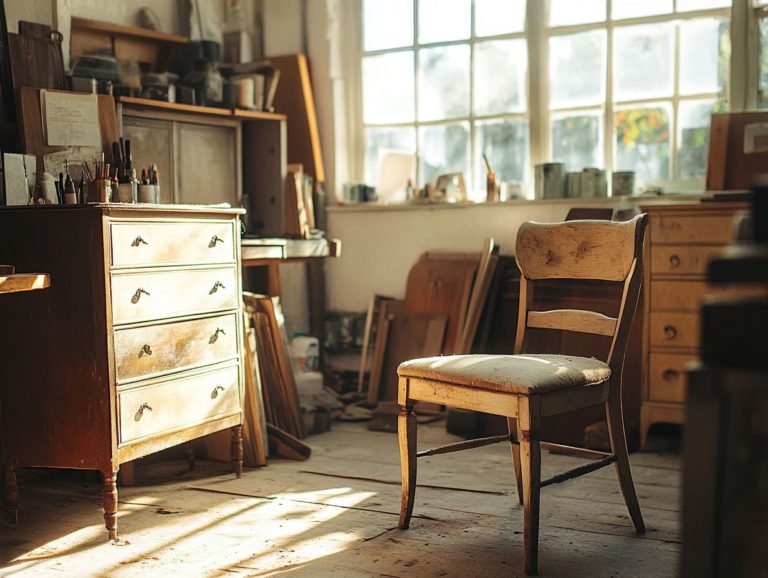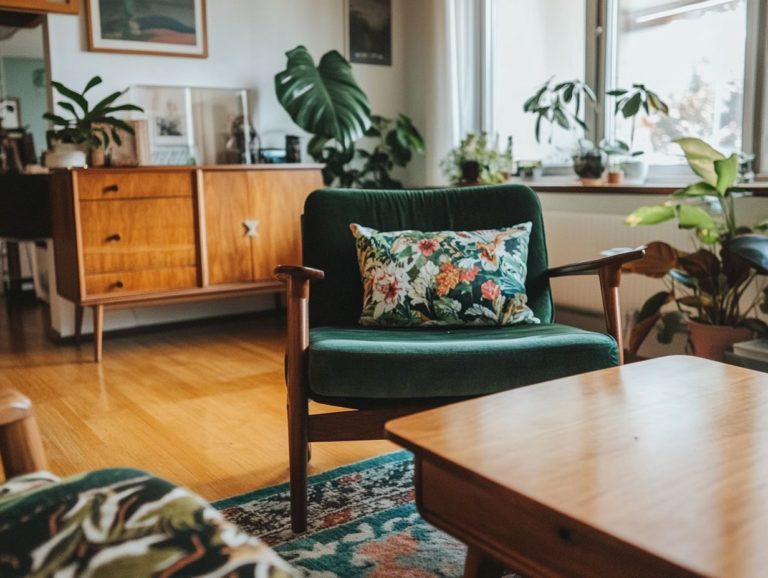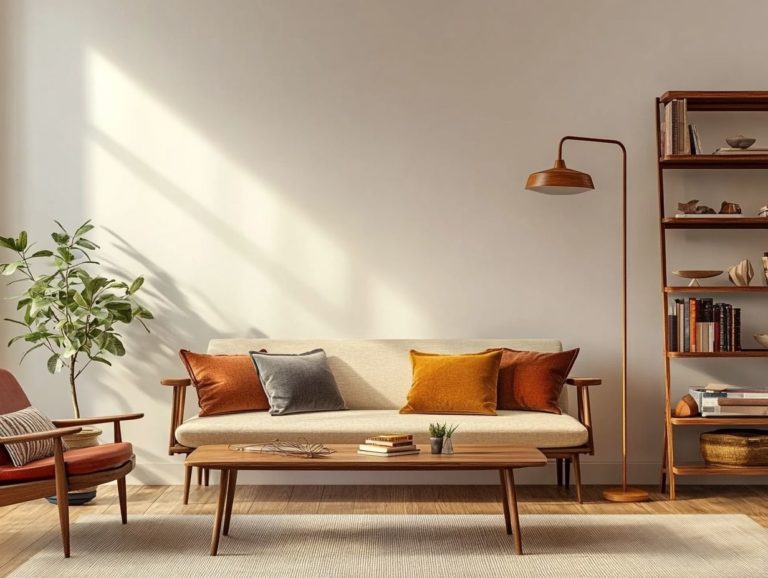The Benefits of Investing in Vintage Furniture
Vintage furniture presents a distinctive fusion of history, craftsmanship, and character that many modern pieces simply cannot replicate. Join us on an exciting journey to uncover the origins and evolution of vintage furniture!
Investing in these exceptional, high-quality pieces is not just a choice; it s a smart decision that can lead to exciting rewards from potential appreciation in value to the environmental benefits of selecting sustainable options.
With insightful tips on discovering and caring for vintage treasures, you can ensure these remarkable items remain beloved elements of your home for years to come.
Contents
- Key Takeaways:
- The History of Vintage Furniture
- Why Invest in Vintage Furniture?
- Tips for Investing in Vintage Furniture
- Maintaining and Caring for Vintage Furniture
- Frequently Asked Questions
- What are the benefits of investing in vintage furniture?
- Can vintage furniture be a profitable investment?
- What makes vintage furniture a better investment than modern furniture?
- Are there any other benefits besides potential financial gain in investing in vintage furniture?
- What should I look for when investing in vintage furniture?
- Can I still invest in vintage furniture if I have a limited budget?
Key Takeaways:
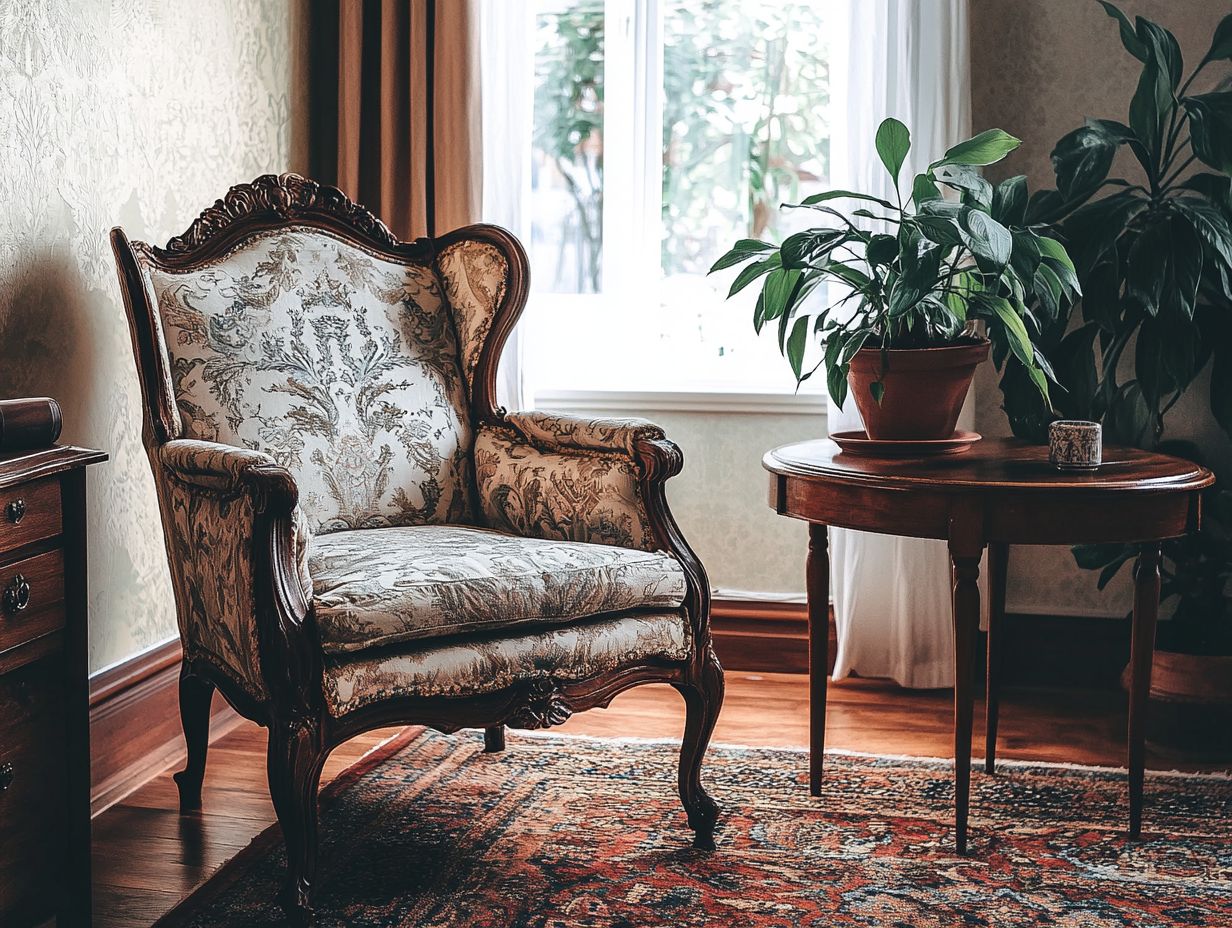
- Vintage furniture pieces are unique and of high quality, making them a valuable investment for any home.
- Investing in vintage furniture can potentially yield a significant appreciation in value over time.
- Choosing vintage furniture is not only environmentally friendly and sustainable, but also a way to preserve history and add character to a space.
Defining Vintage Furniture
Vintage furniture represents a treasure trove of unique, high-quality pieces crafted at least 20 years ago. These items embody a level of style and craftsmanship that s increasingly elusive in today s mass-produced landscape. Each piece reflects the artistic styles of its era while supporting resource conservation and local economies.
When you choose vintage, you’re embracing items marked by enduring quality and meticulous attention to detail. Each piece tells a rich story that modern furniture simply cannot replicate. Unlike antiques, which are typically over 100 years old, vintage pieces provide an accessible path to enhancing your living space while also understanding the role of vintage furniture in eco-friendly homes.
This revival isn t merely a nostalgic nod; it s a conscious choice that aligns with sustainable living principles. By opting for vintage furniture, you actively contribute to waste reduction and cultivate a deeper appreciation for quality craftsmanship, thereby supporting a more eco-friendly lifestyle.
The History of Vintage Furniture
The history of vintage furniture offers a captivating journey through a tapestry of design movements. You’ll encounter prominent styles like Art Deco and mid-century modern, each reflecting the evolution of craftsmanship and aesthetics over the decades.
This exploration highlights the artistry of each era while underscoring the importance of environmental sustainability, a vital consideration throughout these periods.
Origins and Evolution of Vintage Furniture
The origins of vintage furniture take you back to an era where craftsmanship reigned supreme over mass production, leading to distinctive pieces that encapsulate cultural and social dynamics. This contrasts starkly with today s fast furniture market, which often overlooks sustainability and quality.
As you explore the historical timeline, you’ll encounter pivotal moments like the Arts and Crafts Movement in the late 19th century, a time that celebrated handmade production and simplicity in design. Local dealers play an essential role in preserving these vintage treasures, bridging the gap between collectors and the rich heritage each piece carries.
The sustainability movement has emerged as a crucial response to the environmental impact of disposable furniture, championing the reuse of these enduring items. By embracing the past, you re honoring craftsmanship while making more environmentally conscious choices that resonate with today s values.
Why Invest in Vintage Furniture?
Don t miss your chance! Investing in vintage furniture is a smart financial decision that can lead to exciting rewards. Besides its potential to appreciate in value over time, it also presents a host of environmental benefits.
By choosing vintage, you contribute to sustainability through resource conservation and significantly reduce your carbon footprint compared to buying new furniture.
Discover the Charm in Vintage Furniture That Tells a Story!
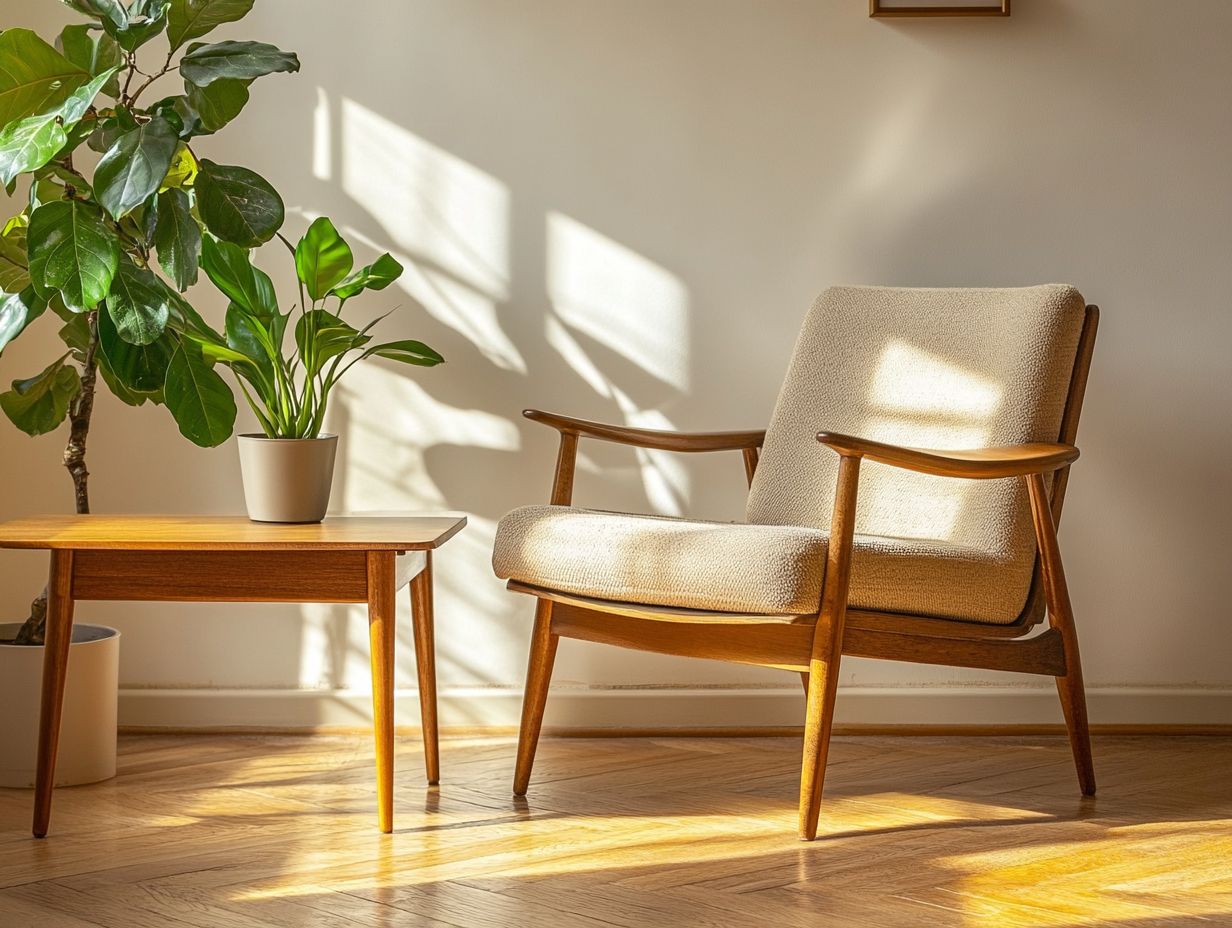
Vintage furniture captivates you with its unique style and exceptional craftsmanship. It often showcases details that modern mass-produced items simply can’t match. This allure is a treasure for interior design enthusiasts and collectors alike.
What truly draws you in is not just the distinctive aesthetics of these pieces but also the rich stories they carry. They reflect the era and culture from which they emerged. The intricate carvings, hand-applied finishes, and carefully selected materials reveal a level of artistry that stands the test of time. This infuses any space with warmth and character.
Unlike contemporary options that often prioritize efficiency and minimalism, antique furniture embodies a commitment to craftsmanship. It brings a unique charm and history into your home, elevating your overall design while serving as a testament to the timeless charm of vintage furniture and enduring quality.
Unlock the Value of Vintage Furniture
The potential for appreciation in value makes vintage furniture an enticing investment. Over the years, these pieces often increase in worth, especially those sourced from local dealers who specialize in high-quality craftsmanship and unique styles.
This appreciation hinges on several factors, including rarity and condition. Items that tell a story or hail from a distinguished maker typically command higher values. If you’re looking for such pieces, consider exploring the best places to find vintage furniture. A well-maintained piece crafted from durable materials is likely to retain its beauty and functionality over time, enhancing its investment appeal.
By engaging with local dealers, you gain access to expertly curated selections and valuable insights into market trends. This ensures that your purchases are well-informed and aligned with your aesthetic and investment goals.
Choose Vintage Furniture for a Sustainable Impact!
Choosing vintage furniture to make a positive impact on the environment plays a crucial role in sustainability. It minimizes waste and reduces the carbon footprint linked to new manufacturing processes.
When you opt for pre-loved pieces, you actively help divert items from landfills. By doing so, you conserve valuable resources like wood, metals, and textiles that would otherwise go into new production while cutting down on the excessive energy required to manufacture new furniture. Additionally, incorporating vintage items can enhance your space, showcasing the impact of vintage furniture on interior design.
Embracing vintage furniture reflects a lifestyle choice dedicated to environmental stewardship. This practice not only curtails pollution but also fosters a sustainable mindset that benefits both the planet and future generations. When considering adding vintage pieces, it’s important to know what to look for when buying vintage furniture to ensure quality and authenticity.
Tips for Investing in Vintage Furniture
Investing in vintage furniture demands a discerning eye and a solid understanding of where to uncover authentic pieces. The finest items are often best sourced from reputable local dealers who prioritize quality craftsmanship.
These experts not only offer exquisite selections but also share valuable insights into the history of each item. This enriches your investment experience.
Where to Find and How to Authenticate
Finding vintage furniture is an adventure that often leads you through local dealers, antique shops, and online marketplaces. However, the secret to a successful purchase is knowing how to authenticate each piece to guarantee its quality and originality.
By diving into the rich history of every item and familiarizing yourself with hallmark signs of age, you can unearth real treasures. A close examination of the joinery and finishes can offer valuable insights into craftsmanship.
Look for dovetail joints and hand-carved features, which are typically indicators of quality. Don t hesitate to consult reputable sources who can provide invaluable guidance or even appraisal services.
Engaging with local dealers can open doors to exclusive finds, while attending antique shows allows you to forge connections with knowledgeable sellers. Ultimately, sharpening your eye for detail and investing time in research will significantly increase your chances of securing true vintage gems.
Start your vintage furniture journey now and find pieces that inspire you!
Factors to Consider when Purchasing

When you re on the hunt for vintage furniture, several factors demand your attention: the quality of craftsmanship, the condition of the piece, its historical significance, and how well it aligns with your sustainability values.
Consider the materials used in the furniture’s construction. Choosing environmentally friendly options can reduce your ecological footprint and enhance your aesthetic.
The style and era of the piece can also elevate your living space, imbuing it with a unique charm and rich character that tells a story.
Understanding the provenance adds depth and value to your find. It transforms the piece from mere functionality into a captivating conversation starter.
Lastly, assessing the restoration potential is crucial. Some vintage items may need a little tender loving care (TLC), allowing you to engage in sustainable practices by breathing new life into quality craftsmanship. Choosing vintage furniture is a sustainable choice that contributes to this effort.
Maintaining and Caring for Vintage Furniture
Caring for your vintage furniture is essential! It keeps both its beauty and functionality intact. Use various preservation techniques that protect against common issues like wear and tear, ensuring its durability for years to come.
Preservation Techniques and Common Issues
Effective preservation techniques for your vintage furniture involve regular cleaning, careful handling, and suitable storage solutions. These practices help mitigate common issues like fading, scratches, and structural damage.
In addition to these foundational methods, using specialized cleaners tailored for specific materials can significantly extend the lifespan of your vintage treasures. It s wise to create a controlled environment by steering clear of direct sunlight and high humidity, both of which can lead to warping or mold growth.
For wooden items, periodically applying a quality wax or polish not only enhances the finish but also adds a protective layer against minor abrasions. Don t forget the little things: using coasters and felt pads can protect surfaces from moisture and scratches caused by everyday use, ensuring your vintage gems remain as stunning as they were when first crafted.
Frequently Asked Questions
What are the benefits of investing in vintage furniture?
Investing in vintage furniture allows you to own unique and timeless pieces that can potentially increase in value over time.
Can vintage furniture be a profitable investment?
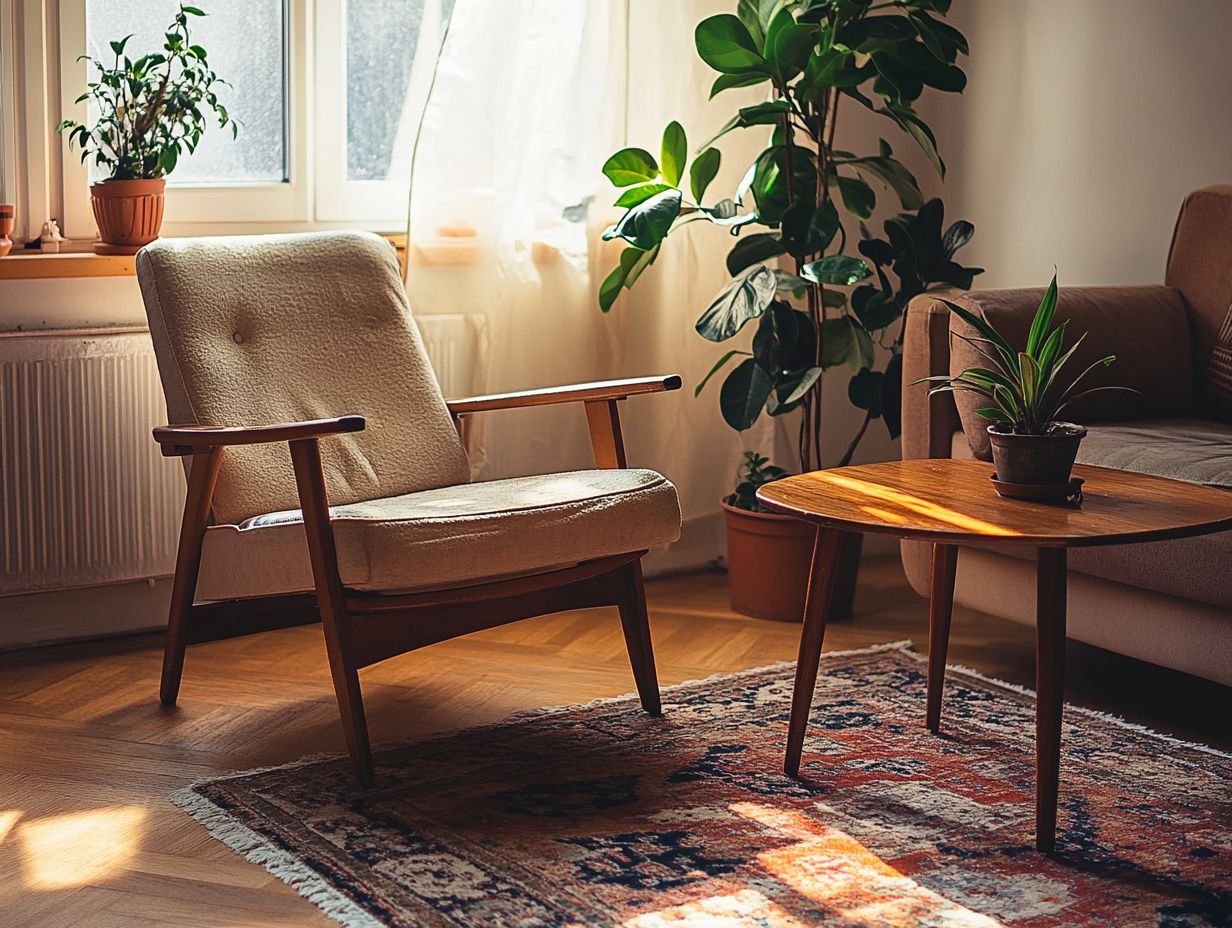
Yes, vintage furniture can be a profitable investment as it tends to hold or increase in value over time, especially if it is well-maintained and in high demand.
What makes vintage furniture a better investment than modern furniture?
Vintage furniture is often made with higher quality materials and craftsmanship, making it more durable and long-lasting compared to modern furniture. It also has a unique charm and character that cannot be replicated in mass-produced modern furniture.
Are there any other benefits besides potential financial gain in investing in vintage furniture?
Aside from potential financial gain, investing in vintage furniture allows you to have one-of-a-kind pieces that can add character and style to your space. It also promotes sustainability by reducing waste and supporting the reuse of quality items.
What should I look for when investing in vintage furniture?
Some key factors to consider when investing in vintage furniture include the condition of the piece, the materials used, and its authenticity. It is also important to research the market value and demand for the particular piece or style.
Can I still invest in vintage furniture if I have a limited budget?
Yes, there are many affordable vintage furniture options available. If you are willing to do some research and hunt for deals, you can start small and gradually build your collection over time.
Start preserving your vintage treasures today! Your home will thank you.

